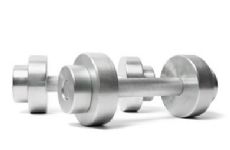|
Strength training is an important part of any workout program, but it's not without its risks. That's why I am always (over)emphasizing safety and form in my workout videos and in real life when I lead people through a class. When you're hoisting weights around, especially when attempting new moves your body isn't accustomed to, your risk of injury goes way up compared to exercises that use your body weight alone. Case in point: A study published last year in the American Journal of Sports Medicine found that between 1990 and 2007, almost 1 million Americans injured themselves badly enough to warrant visits to the ER. And during that nearly two-decade time period, strength-training injuries increased by 48% annually. These injuries ran the gamut from minor sprains and strains to serious issues like dropping weights on one's own body or crushing a body part (like a foot or hand) between weights or weight equipment. Ouch. But don't think that only newbies are at risk. It's easy to slack off on your form when you've been lifting weights for a while, and the fitter you get, the heavier weights you should be lifting—which means you're even more at risk. So whether you're new to weight training or a seasoned pro, here are four quick tips to remember so you can stay away from the doctor, too! 4 Things to Remember During Weight Training Warm Up before You Weight Up This is a given before any workout. A little bit of a warm up is better than none at all, so even if 2-3 minutes is all you can muster before you get down to business, that's better than skipping it entirely. A quick walk or jog, some body weight squats, or a few dynamic stretches are all you need to get your muscles and joints prepared to pump some iron. Low and Slow On any exercise that you're trying for the first time, start with LOW weight—or no weight. When you're doing something new, the first goal should be perfecting the exercise in good form. Once that's done, then think about adding more weight. Slow refers to your tempo. Don't rush through an exercise as fast as you can. Think about a 2:4 count. Lift the weight for two counts, and lower or return it to the starting position for four counts. Focus on Form I can't emphasize enough how important good form is during weight training. It is the #1 thing every exerciser should focus on in order to avoid injury and get the most out of any exercise. If you're not sure how to do an exercise correctly, use all the resources at your disposal to figure it out: ask a trainer at the gym, look up detailed instructions online, ask a fellow exercise, etc. Don't forget, too, that mirrors are your friend. Watch yourself when you work out as often as possible, looking for alignment (head over neck; ankles, knees and hip bones in line, etc.) and control (like keeping your shoulders from hiking up to your ears). If exercising at home, set up an inexpensive wardrobe mirror in your workout area. Mo Momentum, Mo Problems If you listen to the first two points above, then you know that moving weights with momentum is bad news. Momentum doesn't allow the slow 2:4 pace, and it throws good form out the window. This is probably one of the most common issues I see at the gym: people swinging weights around, using too much momentum in order to complete an exercise. You may think you look cool or are getting stronger by swinging that huge dumbbell around, but trust me, the opposite is true. You are not really lifting that weight (so it won't make you stronger than using a lighter weight in slow, controlled form), and you don't look cool jarring your body all around like a fish out of water in order to do it. If you have to use momentum to complete an exercise, you need to rethink the weight you've chosen to lift, plain and simple. (The only exception to this rule would be explosive training such as kettlebells or Crossfit under the guidance of a certified professional.) For more safety tips for strength training, check out this story from bnd.com that features even more of my best injury-prevention tips! Do you mind all four of these pointers when you work out? Have you ever injured yourself during weight training? |
Popular EntriesRelated Entries
More From SparkPeople
|























